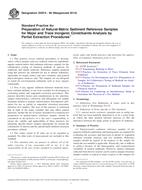Potřebujeme váš souhlas k využití jednotlivých dat, aby se vám mimo jiné mohly ukazovat informace týkající se vašich zájmů. Souhlas udělíte kliknutím na tlačítko „OK“.
ASTM D5074-90(2014)
Standard Practice for Preparation of Natural-Matrix Sediment Reference Samples for Major and Trace Inorganic Constituents Analysis by Partial Extraction Procedures
Automaticky přeložený název:
Standardní praxe pro přípravu Natural-Matrix Sediment referenční vzorky pro hlavní a Trace anorganické složky analýzy částečným extrakční postupy,
NORMA vydána dne 1.1.2014
Informace o normě:
Označení normy: ASTM D5074-90(2014)
Poznámka: NEPLATNÁ
Datum vydání normy: 1.1.2014
Kód zboží: NS-29742
Počet stran: 4
Přibližná hmotnost: 12 g (0.03 liber)
Země: Americká technická norma
Kategorie: Technické normy ASTM
Kategorie - podobné normy:
Anotace textu normy ASTM D5074-90(2014) :
Keywords:
ICS Number Code 71.040.40 (Chemical analysis)
Doplňující informace
| Significance and Use | ||||||||||
|
5.1 The objective of this practice is to provide guidelines for the preparation of stable, representative, oxidized, relatively unpolluted, aquatic natural-matrix bed-sediment reference test samples. When prepared as described, such test samples should be useful for collaborative methods testing, to evaluate the precision and bias of test methods, and to evaluate test methods performance during their development. 5.2 The availability of defined representative natural-matrix reference or test samples, closely approximating a variety of typical environmental samples, is a key requirement for the effective collaborative methods evaluation and development of test methods, and quality assurance testing. When the composition of the reference or test samples has been determined, either for operationally defined “total recoverable” leaching techniques, or for “total analysis” determined by total dissolution, the defined samples should also be suitable for analytical quality assurance testing. 5.3 Certified analyses of most rock, sediment, sludge, and soil reference samples are typically based on the total amount of each constituent of interest in the entire sample. “Total” chemical analysis of these samples generally requires complete decomposition or dissolution of the standard material. These are the only feasible analytical approaches if knowledge of finite concentrations for each element of interest in the entire sample is required. Certain instrumental methods, such as X-ray fluorescence or neutron activation analysis, may provide information as to the total constituent composition without sample destruction. 5.4 Partial chemical extraction of sediments, or “total recoverable” analyses (operationally defined procedures) for selecting constituents, frequently are useful for defining “available” constituent concentrations. In addition, partial chemical extractions may also provide data on partitioning, phase associations, or on how trace elements are entrained. Operationally defined extractable trace constituent concentrations are generally best obtained by using very specific reagent mixtures and extraction procedures, including method of mixing, vessel size and shape, extraction time, temperature, and so forth. 5.5 The various iron and manganese oxides and hydroxides, clay minerals, and organic solutes and particulates, that commonly occur as coatings on most oxidized sediment particles, are generally recognized as the controls governing the concentrations and distribution of most trace metals in natural water-sediment hydrologic environments. Anthropogenic sources clearly dominate in the number of sources and in total loading to most systems, although other factors may also be important.1.1 This practice covers uniform procedures to develop, select, collect, prepare, and use oxidized, relatively unpolluted, aquatic natural-matrix bed-sediment reference samples for the collaborative testing of chemical methods of analysis for sediments and similar materials. Reference samples prepared using this practice are intended for use as natural sediments, analyzable for major, minor, and trace elements, and general physical/organic analyses only. The samples are not designed or tested for environmental pollutants such as trace organic compounds. 1.2 Few, if any, aquatic sediment reference materials have been certified, defined, or are even available for developing or evaluating partial and sequential extraction procedures. This practice describes factors and considerations in site selection, sample characteristics, collection, and subsequent raw sample treatment needed to prepare natural-matrix bed-material sediments for use as partial or sequential extraction procedure reference test samples. The user of this practice is cautioned that in light of the many variables that may affect natural materials, neither the list of factors included for evaluation nor preparation of natural-matrix reference samples should be considered as all inclusive. It is the user's responsibility to ensure the validity and applicability of these practices for preparing specific-matrix samples appropriate for testing the constituents of interest and the operationally defined extraction procedures utilized. 1.3 The values stated in SI units are to be regarded as standard. No other units of measurement are included in this standard. 1.4 This standard does not purport to address all of the safety concerns, if any, associated with its use. It is the responsibility of the user of this standard to establish appropriate safety and health practices and determine the applicability of regulatory limitations prior to use. |
||||||||||
| 2. Referenced Documents | ||||||||||
|
Podobné normy:
Historická
1.9.2012
Historická
1.3.2010
Historická
1.4.2008
Historická
1.3.2014
Historická
15.6.2012
Historická
1.9.2012
Odebírejte informace o nově vydaných normách ZDARMA:
Chcete pravidelně odebírat informace o nově vycházejících normách z celého světa a to zcela zdarma?
Přihlašte se k odběru. Vše je velice jednoduché a absolutně ZDARMA.
Na výběr máte vydavatele z celého světa.



 ASTM E2160-04(2012)..
ASTM E2160-04(2012).. ASTM E222-10
ASTM E222-10 ASTM E2313-08
ASTM E2313-08 ASTM E2326-14
ASTM E2326-14 ASTM E2330-12
ASTM E2330-12 ASTM E2403-06(2012)..
ASTM E2403-06(2012)..
 Cookies
Cookies
